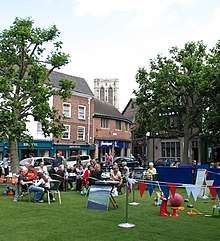St Sampson's Square
St Sampson's Square is an open space, and former marketplace, in the city centre of York, in England.

History
In the 12th-century, the area now occupied by the square was known as Arkilltofts, possibly named after Arnketil, a leading figure in the city around the time of the Norman Conquest. It was a large open space, occupying the south-eastern corner of the former Roman fortress. By 1130, it was owned by the royal larderer. At this time, he held responsibility for the sale of meat in the city, and a market gradually developed in the area. Initially, the site occupied around 10,000 square yards, although this has been reduced over time, as buildings encroached on the space, forming a square.[1]
By about 1250, the square was named Thursday Market, suggesting that, at the time, it hosted a market just one day a week. By the 14th-century, it was known in particular as a place to buy meat, although in the following century, only traders from outside the city could sell in the square, with York-based merchants instead confined to the nearby Shambles. The square was also the main location for the sale of fabric, and at times, baked goods, wool, candles, and certain other foodstuffs were also sold in the market. By the 16th-century, markets were held on Tuesday, Thursday, and Saturday, and in 1593, a Friday market was added for linen and other cloths.[2]
In 1421, the widow of John Brathwayt, a former Mayor of York, donated 20 marks for the construction of a market cross, and a guard house was later built alongside it. In 1704, Elizabeth Smith, who leased the square, obtained permission to demolish the cross, and in its place she built a small market hall, with a statue of George II.[2]
In 1765, a school was established in the upper chamber of the market hall, but it moved elsewhere in 1786. In 1818, the location became known as "St Sampson's Square", after St Sampson, Church Street, which can be seen from the square.[2][3]
By the 1830s, the market had become overcrowded, and Parliament Street was constructed, linking the square with the city's other market, on Pavement, and a large market established along its length. The part of the market in St Sampson's Square continued to specialise in meat, until 1888, when it switched to selling fish. By 1852, there were seven inns around the square.[2][3]
In 1955, the market stalls were moved to what is now Shambles Market, and the square became a car park.[2] It was pedestrianised in 1976,[4] and is now a popular location for festivals and seasonal markets.[5] Public toilets were a feature of the square for many years, but were closed in 2010 and demolished in 2019.[6]
Layout and architecture
The square is largely surrounded by buildings, with roads leading from its four corners: Feasegate leading from the southern corner, Davygate from the western, Finkle Street from the northern, and both Silver Street and Church Street from the eastern. Parliament Street leads south-east, and its broad entrance occupies half of the south-eastern side of the square. In addition, two snickelways connect to the square: Nether Hornpot Lane from the northern corner, and Three Cranes Lane from the middle of the north-eastern side.[3]
The north-western side of the square is dominated by Brown's department store, which was built in 1905, replacing several timber-framed houses. Further along, numbers 5 and 6 date from the 18th-century, and number 7 from the 16th-century. On the north-east side, the Roman Bath pub is noted for the remains of a Roman bath in its cellar, operated as a tourist attraction. The 18th-century Three Cranes Inn is the other surviving pub on the square, while number 12 is also listed. On the south-east side, 13 and 14 St Sampson's Square, and 15 St Sampson's Square are listed. On the south-west side, numbers 1 and 2 are listed, as is Melrose House at number 3, all 18th-century buildings.[3][7]
References
- Rees Jones, Sarah (2013). York: The Making of a City 1068-1350. Oxford: Oxford University Press. ISBN 019820194X.
- A History of the County of York: the City of York. London: Victoria County History. 1961. Retrieved 7 August 2020.
- An Inventory of the Historical Monuments in City of York, Volume 5, Central. London: HMSO. 1981. Retrieved 7 August 2020.
- "The changing fortunes of St Sampson's Square: 6 old views of York". The Press. 19 March 2018. Retrieved 10 August 2020.
- McIlwain, John (2009). York City Break Guide. Jarrold Publishing. p. 85. ISBN 0711726485.
- Laversuch, Chloe (7 November 2018). "York public toilets to be demolished". The Press. Retrieved 10 August 2020.
- Amin, Nathen (2016). York Pubs. Amberley Publishing. ISBN 1445644762.